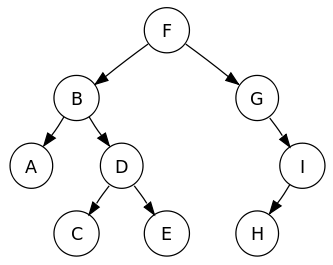Tree traversal algorithms for a binary tree

For the tree above, a tree traversal can be performed in 3 different ways.
Pre-order
[edit | edit source]The first type of traversal is pre-order whose code looks like the following:
sub P(TreeNode)
Output(TreeNode.value)
If LeftPointer(TreeNode) != NULL Then
P(TreeNode.LeftNode)
If RightPointer(TreeNode) != NULL Then
P(TreeNode.RightNode)
end sub
This can be summed up as:
- Visit the root node (generally output this)
- Traverse to left subtree
- Traverse to right subtree
The code outputs the following: F, B, A, D, C, E, G, I, H
In-order
[edit | edit source]The second (middle) type of traversal is in-order whose code looks like the following:
sub P(TreeNode)
If LeftPointer(TreeNode) != NULL Then
P(TreeNode.LeftNode)
Output(TreeNode.value)
If RightPointer(TreeNode) != NULL Then
P(TreeNode.RightNode)
end sub
This can be summed up as:
- Traverse to left subtree
- Visit root node (generally output this)
- Traverse to right subtree
The code outputs the following: A, B, C, D, E, F, G, H, I
For sorted binary trees it will output the nodes in order (in alphabetical order in this case). Watch out though, sometimes you might encounter unordered binary trees that will not produce a sorted list when read in-order!
Post-order
[edit | edit source]The last type of traversal is post-order whose code looks like the following:
sub P(TreeNode)
If LeftPointer(TreeNode) != NULL Then
P(TreeNode.LeftNode)
If RightPointer(TreeNode) != NULL Then
P(TreeNode.RightNode)
Output(TreeNode.value)
end sub
This can be summed up as:
- Traverse to left subtree
- Traverse to right subtree
- Visit root node (generally output this)
The code outputs the following: A, C, E, D, B, H, I, G, F
Rule of thumb
[edit | edit source]There is an easier way to remember how to do this and if you don't have enough time in the exam you can try this way:
- Check that the code is left traversal followed by right traversal
- Check the position of the output line
- Draw the dots on the nodes
- Draw a line around the tree
- Follow the line and write down each node where you meet a dot
So let's take a look at what that all means. First of all, look at the code. If the code has the left tree traversal before the right tree traversal we can proceed (this is true in all cases above and below). How we need to find out where the output line is.
sub P(TreeNode)
'Output(TreeNode.value) REM Pre-Order
If LeftPointer(TreeNode) != NULL Then
P(TreeNode.LeftNode)
'Output(TreeNode.value) REM In-Order
If RightPointer(TreeNode) != NULL Then
P(TreeNode.RightNode)
'Output(TreeNode.value) REM Post-Order
end sub
Depending on where the line to output the node value is this will tell you what sort of tree order traversal they are asking you to do. NOTE: If you have in-order traversal don't jump too soon, the tree may not be sorted!
But how does this help? The next thing you need to do is put a little mark on each node of the tree as follows:

| Type of Traversal | Position of Output code | Where to put your mark |
|---|---|---|
| Pre | Top | Left |
| In | Middle | Bottom |
| Post | Bottom | Right |
Now draw a line around the tree, and follow it around in an anti-clockwise fashion. Your end result should look like one of the diagrams below. Check that your rule of thumb answer matches the answers given above.
- The 3 different types of traversal
-
Pre-order Traversal
FBADCEGIH -
In-order Traversal
ABCDEFGHI -
Post-order Traversal
ACEDBHIGF
NOTE: They may try to trick you using one the following ways:
- Right traversal is before left traversal
- The binary tree is not sorted and they want you to perform in-order traversal
If you have time work it out properly and use this method to help.
Breadth First traversal
[edit | edit source]- Enqueue the root node.
- Dequeue a node and examine it.
- If the element sought is found in this node, quit the search and return a result.
- Otherwise enqueue any successors (the direct child nodes) that have not yet been discovered.
- If the queue is empty, every node on the graph has been examined – quit the search and return "not found".
- If the queue is not empty, repeat from Step 2.

Note: Using a stack instead of a queue would turn this algorithm into a depth-first search.
Depth First traversal
[edit | edit source]See pre-order traversal. Depth first traversal and pre-order traversal are equivalent.
|
Exercise: Depth and Breadth First Traversal
|





